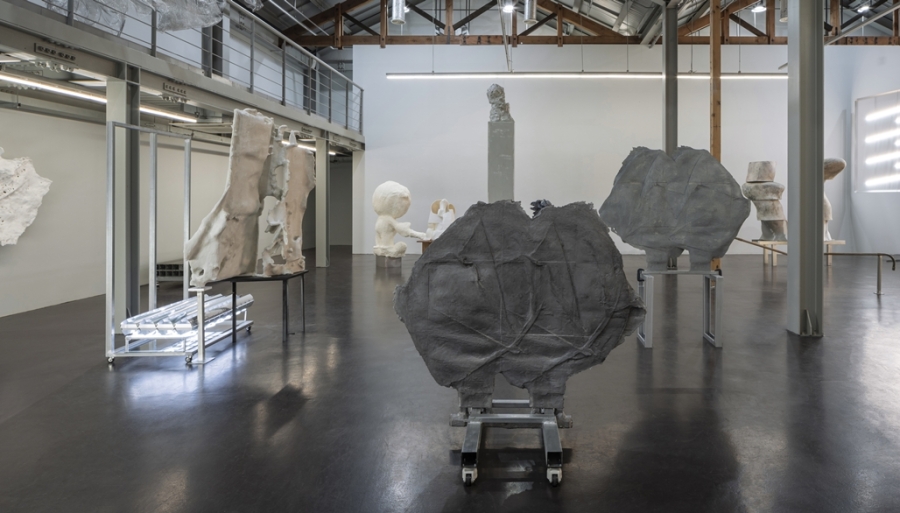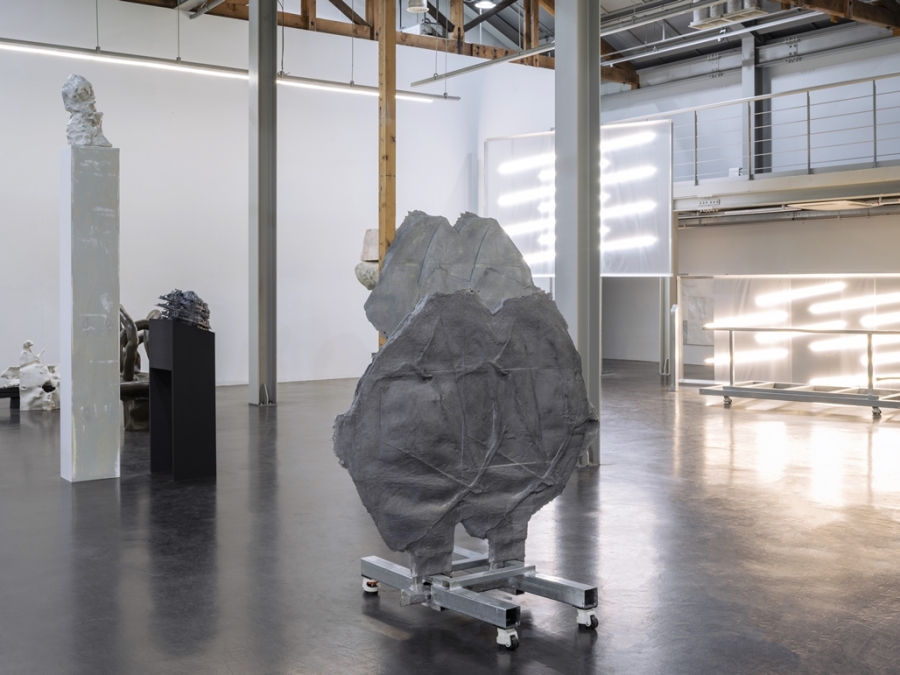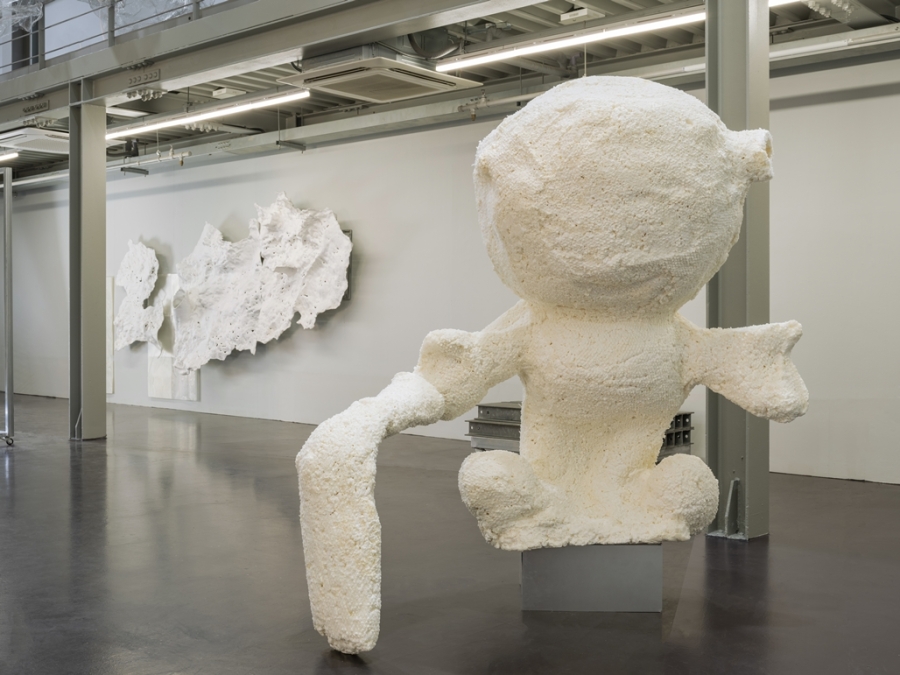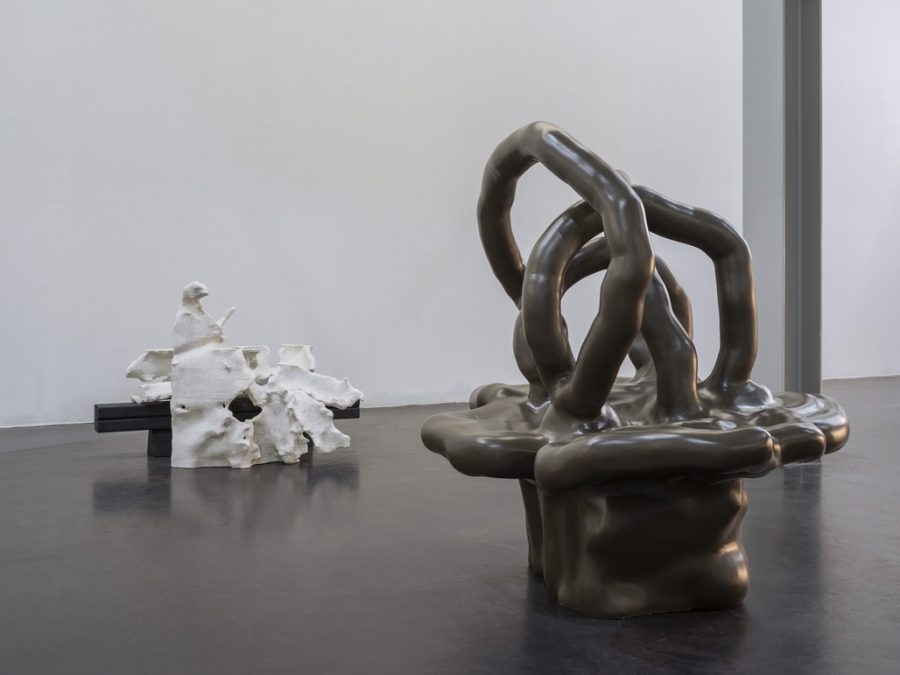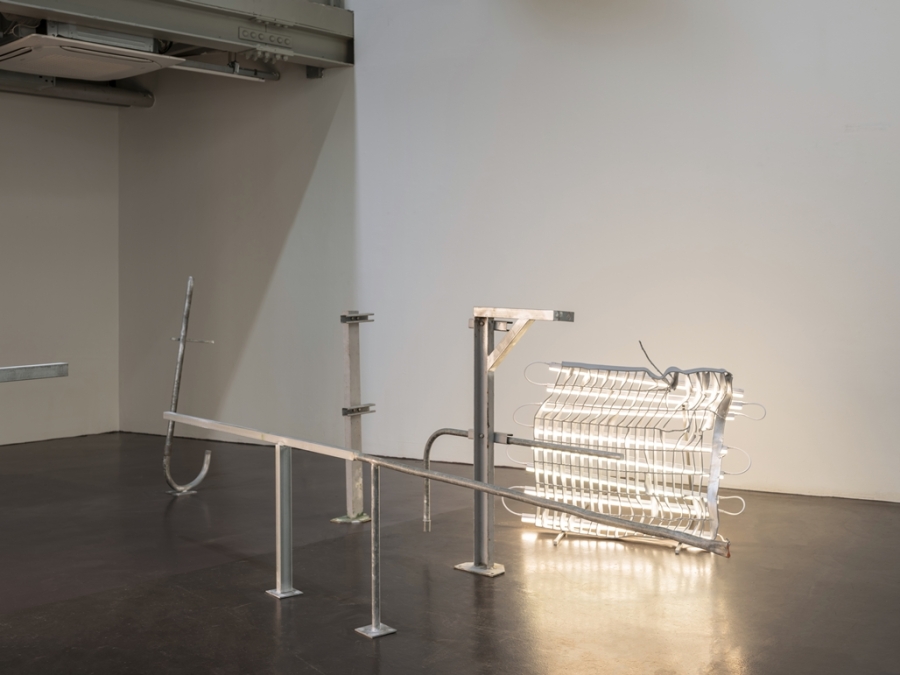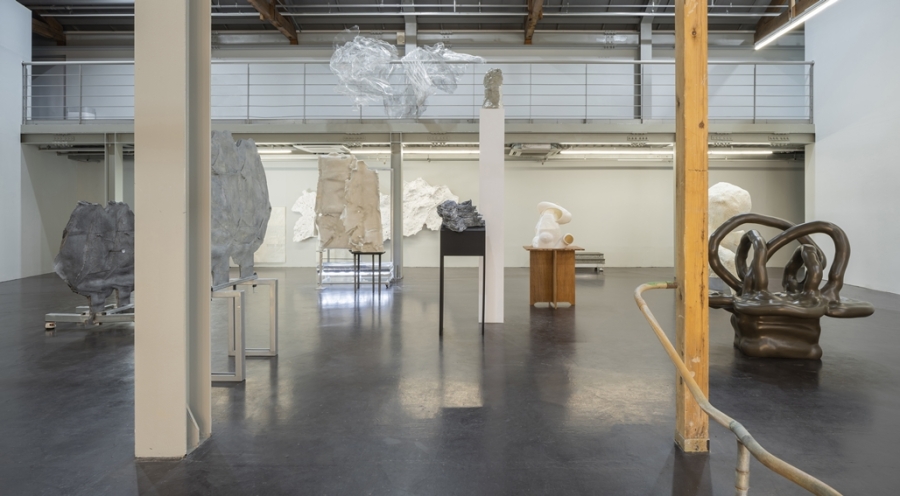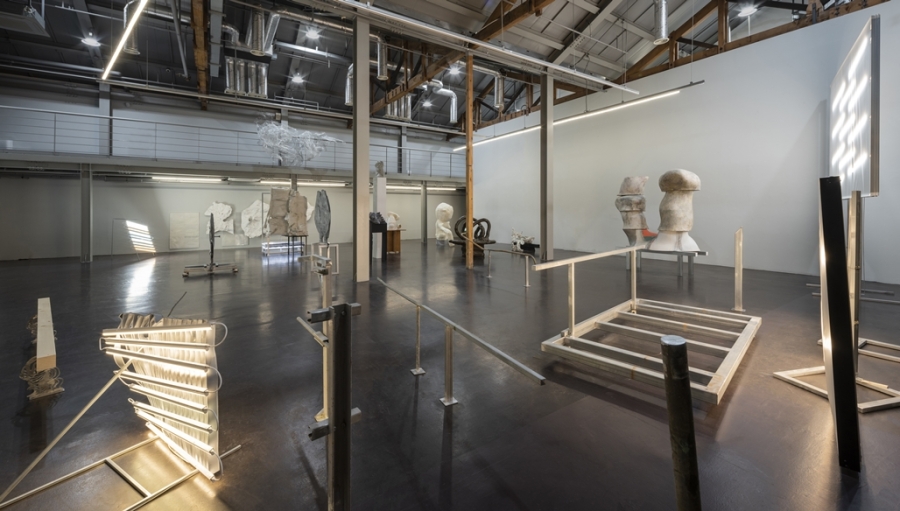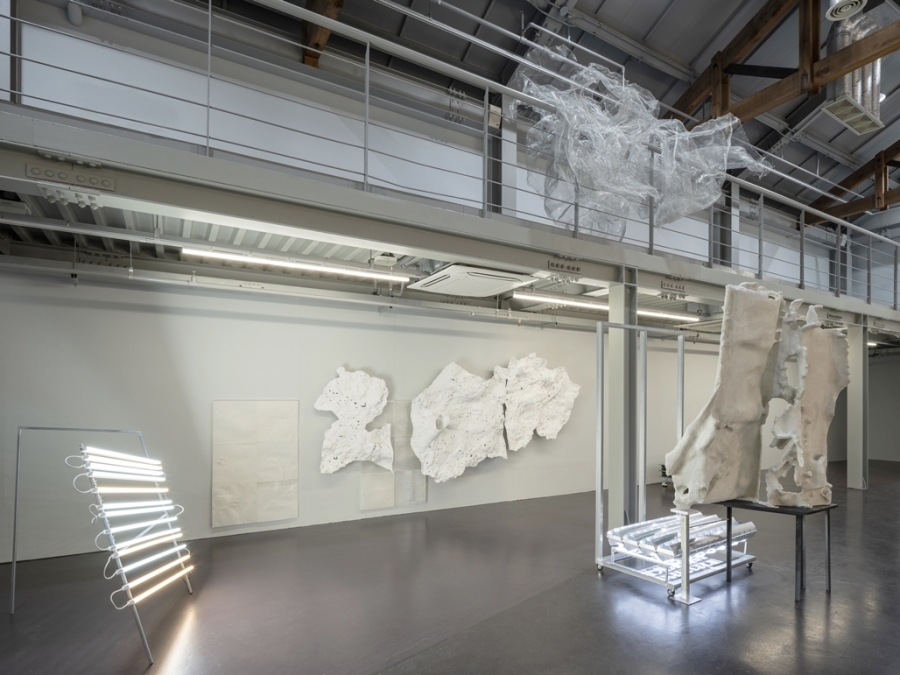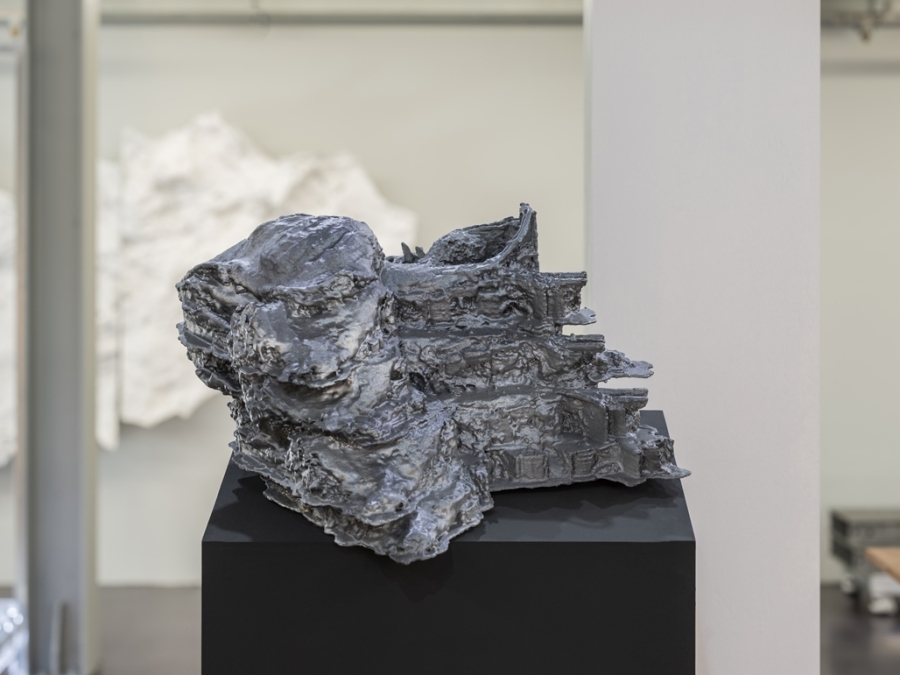멀리 가는 조각
작품이 철수되는 날 아침, 가우지 전시장을 다시 찾았다. 나는 정지현이 만든 조각의 가벼움을 확인하고 싶었다. 물론, 두 오브제가 한 쌍인 작업 스웹(2022)의 하나를 알루미늄 틀에 철을 부어 무겁게 만들고 다른 하나를 폴리락타이드(PLA) 필라멘트를 사용해 3D 프린팅하여 가볍게 만들어 서로 가까이 두었듯 그건 전시가 꼭꼭 숨겨놓은 비밀이 아니었다. 그럼에도 가벼움을 확인하고픈 충동이 사라지지 않은 건 눈앞의 분명한 사물을 도저히 믿지 못하는 ‘도마의 의심’과 비슷했던 것 같다. 저건 견고해 보이지만 사실은 분명 어떠한 허상일 것이다… 심증은 넘쳐났지만 확인할 길은 묘연했다. 전시의 시간이 아니라 작품이 철수되는 날 조각들을 방문한 이유는, 어쩔 수 없이 자리를 이동해야 하는 순간 그들이 숨기고 있던 취약함이 여지없이 탄로 날 것이라 추측했기 때문이다. 그리고 직접 붙들어보지 않고 인부들이 작품을 들어 올려 옮기고 포장하는 모습을 통해 그 가벼움을 살펴야겠다고 생각한 것은 이 조각들의 가벼움이 단지 질량과 관련하는 것이 아니라 어떤 사회적 관계 속에서 일시적으로 등장하는 장면 전체와 관련하는 것이라 생각했기 때문이다. 즉, 내가 확인하고 싶었던 가벼움이란 조각의 물질성이 아니라 무심한 사람들이 이 물건을 다루는 몸짓 속에서, 또 물건이 사람들 사이를 흘러 다니는 시간 속에서 가지게 되는 특별한 존재감을 통해 진술하는 어떤 현실이었다. 조각이 이미 스스로 자신이 시작하게 된 최초의 아주 구체적인 것으로부터 멀리 떠나왔고 떠나가는 중인데 그것으로 내가 돌아가는 것이 무슨 의미가 있겠는가? 가까이 다가가고픈 충동은 오히려 멀어짐으로써만 해결된다. 나는 이것이 동시대 조각 실천이 가지고 있는, 근대적인 조각 만들기와는 다른 방향의 발걸음이자 우리를 초대하는 방식이라 생각한다.
가우지 전시장에 처음 들어섰을 때 내가 느낀 당혹스러움과 놀람은 태연히 놓인 저 묵직해보이는 조각들이 사실은 자신들이 얼마나 가볍고 텅 비어 있는지를 뽐내고 있었기 때문이었다. 그렇다고 해서 그것들이 그 텅 빔 혹은 껍데기만 남은 가벼움을 (많은 예술작품이 불안에 못 이겨, 또 욕망에 허우적거리며 그러하듯) 스스로 미학화 하고 있는 것은 아니었고, 또 (역시 많은 예술작품이 그러하듯) 짐짓 어떤 식으로 보이고 싶어 하는 자의식이 있지도 않았다. 그러니까 그건 그저 그러할 뿐인 존재였는데, 그렇다고 해서 ‘사물의 소멸’을 섣불리 말하며 오늘날의 존재론을 표상하지도 않는다. 여기서부터 해석적 난관이 있는 것처럼 보인다. 그런데 이 이상한 사물이 무엇인지 묻지 않고 이것이 어떤 장소에 있는가에 관해 생각해보면 조금 다른 해석이 열린다. 내게 이 조각들은 어딘가에서부터 어딘가로 가고 있는 중인 무언가로 보였는데, 다르게 말하면 그것은 어떤 공간을 가로질러 나아가고 있는 중인, 운동 중인 것이었으며 그의 조각이 보여주는 것은 그러한 공간적 여정이다. 아리스티드 마욜의 청동 조각상 강(La Rivière)(1938)의 스캐닝 데이터를 온라인에서 만난 익명의 사람에게서 전달 받아 레진으로 프린팅 한 멀리서 온 토르소(2022)는 작가의 상상적 공간에서 조각이 이루어지는 과정을 가장 이해하기 쉬운 방식으로 보여주는 작업이다. 지구 반대편에 굳건히 자리를 가지고 있던 무거운 물질이 지금 이곳에 당도하며 가벼워지고 분해되고 재조립된다. ‘지구 반대편’이라는 아득히 먼 지리적 공간, ‘청동과 데이터’라는 대비되는 물질성과 ‘분해와 재조립’이라는 형태적 변화는 멀어짐으로써 가까워지는 매우 특수한 예술적 실천인 조각의 시간성 자체에 관한 비유이다. 중요한 것은 이것이 저것으로부터 기인했다는 것이 아니라 이것이 어딘가로부터 떠나왔다는 것, 이동이다. 멀리서 온 토르소는 현실의 한 구체적 대상이 정지현의 조각적 사유 공간에서 어떤 여정을 하던 중 일시적으로 가시성을 얻어 등장한 형상이다.
정지현의 작업은 명백한 것들 투성이다. 매립지(2021-2022)나 갯벌(2022), 공원(2022)은 그가 어디에 가고 걸었는지 말해주고, 해치(2021)나 월디(2022), 더블데커(2018), 페기(2021-2022)는 그가 어떤 사물들에 관심을 보였는지를 말해주고, 벽난로와 기둥(2022), 내 이웃의 벤치(2021) 프로젝트는 그가 어떤 기술과 방법을 사용했는지를 잘 말해준다. 모호하거나 비밀에 부쳐진 것은 거의 없다. 그런데 그가 방문한 곳의 장소성, 그가 주목하는 사물의 사물성, 그가 다루는 기술과 도구의 성격을 논의함으로써 그의 작업 전모를 밝혀낼 수 있을까? 분명 가우지 이전까지는 유효한 구석이 있었던 것 같다. 돌이켜보건대, 정지현은 개인전 곰염섬(두산갤러리, 2016)을 통해 더 이상 작업에 내러티브가 스며들지 않도록, 아니 내러티브로 작업이 흘러가지 않도록 하겠다는 선언을 한 후, 그간 조각이라는 것이 무엇인지, 조각은 무엇을 하는 것인지 일견 단순해 보이는 질문을 끊임없이 탐구해 왔다. 그 탐구의 과정 속에서 그는 자기 자신에게 어떠한 장소가, 어떠한 사물이, 어떠한 방법이 어떤 방식으로 의미가 있는지 스스로 이해해 나가며 그것들을 통해 조각을 어떻게 가능하게 할지 살폈다. 나는 그의 등을 보고 뒤따라 걸으며 그가 그때그때 관심 가지고 살피는 장소의 장소성, 사물의 사물성, 매체의 개념 등에 관해 그가 어떻게 그 장소와 사물을 이해하고 방법을 형성하는지 관찰했었다. 그 과정은 가까이에서 보면 치열한 전투 같았지만 멀리서 보면 느릿하고 답답하고 지난했다. 그럼에도 불구하고 아직 그의 작업이 조각의 내부를 형성했다고 하기에는 어딘지 충분해 보이지 않았다. 달리 말하면 그의 조각은 아직 충분히 멀리 가지 못했던 것 같다. 그래서 나 또한 조각이 무언가를 주섬주섬 줍고 있는 조각의 외부를 함께 서성거렸었다.
수두룩한 명백함이 정작 작업의 시간에 대해서는 알려주지 않는다고 느꼈을 때, 아니 좀 더 정확하게는 명백한 것들이 진술하지 못하는 어떤 공간이 생겨났다고 느꼈을 때, 나는 비로소 그의 작업이 형성한 조각의 내부에 관해 생각해볼 수 있게 되었다. 여기서 내부란 조각이 자기 자신을 구축해 나가는 매우 자율적인이고 일시적인 공간, 자기 자신을 형성하는 기억이 축적된 지층 같은 공간이다. 예술 실천뿐만 아니라 모든 사물은 저마다 이 공간을 가지고 있다. 어떤 사물은 너무 협소하여 존재한다고는 생각지도 못할 만큼 작은 공간을 가지고 있는 반면, 어떤 사물은 너무 크고 복잡한 공간을 가지고 있어서 신비로움을 사로잡는다. 조각이란 건 (사물이 아닌) 이 공간들을 가로지르는 일이다. 사실 오늘날 이 불길한 공간을 가장 적극적으로 또 능수능란하게 도입하는 것은 자본주의다. 예컨대 한 빈털터리가 하루아침에 벼락부자가 되었을 때, 누구나 그 사람의 부가 어떤 공간을 거쳐 변형되었다는 것을 알고는 있지만 그 공간이 도대체 무엇이었는지 거기서 무슨 일이 일어났었는지는 누구도 알지 못한다. 많은 경우 도깨비 방망이라거나 차트 분석 같은 납득할만한 허구를 도입하여 안정화한다. 반면 비평이라는 것은 그 공간을 봉합하는 대신 그 불길함을 견디고자 했다.
“모든 견고한 것들이 대기 속으로 녹는다(All that is solid melts into air).” 현대성을 관통하는 이 유명한 문장은 정지현의 조각 내부 공간에서 일어나는 일을 추측하기에도 적절한 것 같다. 여기서 몇몇 오해를 피하자면, 그가 무너뜨리고 다시 생성하는 것은 가시적인 형태가 아니다. 알만한 것을 알만하지 않게 만드는 눈속임을 통해 마치 끊임없이 새로움이 나타나는 것처럼 보이는 착시를 불러일으키지 않는다. 그보다는 수고스럽게 사물의 표면을 떠내어 형태를 보존하는 일에 집중하는데, 그러면 닮은 형태는 남지만 저것을 구성하는 물질은 모조리 사라진다. 남은 그것은 무언가와 여전히 닮았지만 닮은 저것과는 전혀 다른 무언가가 된다. 그리고 정지현은 바로 이 과정에서 발생하는 사건에만 이러저러하게 관여할 뿐이다. 예컨대 월디나 해치는 공공기관의 마스코트 조형물의 표면을 알루미늄 망으로 떠내고 이를 거푸집 삼아 우레탄 폼을 채운 후 남은 것이다. 남은 것은 가볍고 귀엽지만 어딘지 으스스하다. 어떤 것은 선명한 얼굴을 가지고 있지만 어떤 것은 머리 한 귀퉁이가 무너져 있다. 후라이드 플라워는 3D 스캐닝한 꽃을 3D 프린팅 하는 도중 조형물이 받침대에서 이탈하며 꽃이란 걸 알아볼 수 없는 기괴한 형상을 가지게 되었는데, 정지현은 그 실패한 상태를 전시장에 태연히 가져다 놓았다. 각각의 작품은 저마다의 조각적 사건을 가지고 있고, 정지현은 그것을 가만히 들여다보고 있었음이 틀림없다. 그것이 과연 가능한 멀리 나갔는지를 확인하며, 그 멀리 감이 동시에 무엇과 가까워졌는지를 확인하며. 그런 면에서 가우지는 무엇보다도 조각의 내부를 탐구한 전시라고 하는 것이 옳다. 그렇다면 그 내부를 경유해 등장하게 된 것, 내가 마주했던 당황스러운 가벼움, 무언가와 닮았지만 절대 그것은 아니라는 이상한 역설을 주장하던 조각들의 존재감은 도대체 무엇을 진술하는 것일까.
나는 올해 여름 아이슬란드에서 한 달 반을 머물렀는데, 직접 가보지 않았다면 몰랐을 사실 중 하나는 그 거대한 섬에는 무수히 많은, 너무나도 많은 조각상이 있다는 것이었다. 레이캬비크에는 골목마다, 광장마다, 몇 걸음 걸을 때마다 육중한 조각상들과 마주칠 수 있었고, 돌과 바람과 하늘밖에 없는 광활한 들판 한가운데에서도, 깊숙한 피요르드 산기슭 아래에서도, 아무도 찾지 않을 것 같은 해변에서도 나는 언제나 조각상과 마주쳤다. 미술사적 지식에서 보자면 대체로 전근대적이거나 근대적인 양식의 조각이었는데, 그것들은 모두 견고했고, 절대 제 자리를 벗어나지 않을 것처럼 무거워보였다. 문제는, 그들이 아이슬란드라는 세계를 너무나도 진실되게 진술하고 있다고 느꼈다는 것이다. 그것은 그들을 구성하는 물질이 그것이 속한 세계를 구성하는 물질과 닮아있다는 것도 있었지만, 뒤늦게 깨달은 것은 그것들이 전혀 움직이고 있지 않으며 그들에 관여하기 위해서는 내가 그것들을 찾아가야만 한다는 사실이었다. 내가 아이슬란드의 조각들에서 배운 것은, 예술적 작업은 그것이 관여하는 특정한 세계와의 관계 속에서 이해해야만 한다는 것이었다. 하지만 동시대 예술은 흔히, 작품이라는 사물이 장소와 아무런 관련이 없다는 것처럼 이해되곤 한다. 물론 어떤 것들은 장소 없음의 장소를 가지고 있겠지만. 아이슬란드에서 조각을 만나는 경험을 하지 못했다면 나는 정지현의 조각에 대해서, 그것이 형성하는 조각적 공간에 대해서 이해할 수 없었을 것이다. 정지현의 조각은 그 단단하고 생동하는 물질들로 가득한 세계의 조각과 정반대로 가고 있었기 때문이다. 정지현의 조각은 한없이 가벼워지며 무언가로부터 멀리 달아나려 한다. 그리고 그 가벼움은 자기 자리를 가지려 하지 않고 복제되어 어딘가를 떠돌아다니려 한다. 마치 어디에서나 들을 수 있는 기술복제시대의 신화처럼. 이것이 작가가 인식하는 세계의 내부가 반영된 것인지는 아직 잘 알지 못한다. 하지만 그가 이 세계에서 조각을 위한 공간을 열어 그곳을 방문하기 시작했다는 것은 분명해 보인다.
I revisited the Gouge exhibition in the morning of the day it was taken down because I wanted to verify the lightness of JUNG Jihyun’s sculptures. Granted, the lightness of Jung’s sculptures was no secret as evident in Swept(2022), a work comprised of a pair of objects with one 3D-printed with light polylactide filament and the other cast from relatively heavier aluminum. Perhaps I was being a “doubting Thomas” because I could not shake the urge to confirm the lightness myself, even though I had witnessed the visible proof thereof. I thought the apparent hardness of the object was surely an illusion. Although there was plenty of circumstantial evidence to underpin my theory, there was no viable way to truly corroborate my suspicion. That is why I chose to revisit the exhibition the day the works were being taken down, as I expected that their inevitable removal and displacement would expose their hidden vulnerabilities in the process. The reason I decided to witness the lightness of the works by watching the crew dismantle and carry them instead of trying to lift them myself is because I thought their lightness were not solely associated with their physical weight but also related to the overall vignettes that momentarily appear in certain societal relationships. In other words, the “lightness” I was hoping to verify was not the physical property of the sculptures’ mass but rather a certain reality demonstrated through the indifferent crew’s handling of the objects and the special sense of existence the sculptures take on as they pass from one hand to another. If the sculptures have already traveled far from their very specific point of origin and are again in transit, what purpose would my revisit serve? Thus, the only way to resolve this urge to draw near was to drift apart. I believe this is the way contemporary sculpture sets itself apart from modern sculpture, and the way it invites us to truly appreciate it.
I felt startled and shocked when I first stepped into Gouge because the ostensibly weighty sculptures nonchalantly sitting in their respective spots flaunted how light and empty they actually are. That is not to say those objects were autonomously aestheticizing their vacuous lightness with nothing left but the husk (as many artworks often do as they succumb to anxiety or flounder through desire), nor that they self-consciously desired to flaunt such emptiness (as is also often the case with artworks). In short, they simply existed; but that does not mean one can then jump to the discussion of “non-things” or today’s ontological theories. Therefore, it is at this juncture that we begin to face challenges in interpretation. However, if we begin to think about the place of these objects instead of questioning what their existence is, we may open the door to a slightly different interpretation. To me, these sculptures appeared to be moving from point A to point B, i.e., in motion through a certain space. It is such spatial journey that the artist’s sculpture conveys. By exchanging 3D scan data with an anonymous person online, Jung took the dimensions of La Rivière(1938) by Astride Maillo (1861 – 1944) and recreated a 3D-printed resin piece titled Torso from Afar(2022). The process behind this work is perhaps one of the easier to understand, demonstrating how the artist generates the sculpture in his fictional space. A heavy substance that once remained affixed on the opposite side of the planet has become lighter, disassembled, and reassembled upon its arrival here. The geographically distant concept of space defined as “the opposite side of the planet,” the contrasting materiality between “bronze and data,” and the transformations of “disassembly and reassembly” serve as metaphors of the temporality of sculpture, which is unique as an artistic practice in that growing distant leads to proximity. The important thing is not to determine the answer to the chicken-or-egg question, but rather that the object has departed from some point of origin, i.e., movement. Torso from Afar appeared as the result of a specific subject of reality momentarily gaining visibility while journeying through Jung’s sculptural domain of fiction.
Jung’s works are full of clarity. Landfill(2021-2022), Foreshore(2022), and Park(2022) show where he has been and walked. Hatchi(2021), The Last Worldee(2022), Double Decker(2018), and Peggy(2021-2022) demonstrate which objects drew his attention. Fireplace and a Pillar(2022) and My Neighbor(2021) unveil his techniques and methods. There is rarely anything ambiguous or secretive about Jung’s works. However, one cannot help but wonder if discussing the locality of the places he visited, the objecthood of the things he observed, and the nature of his techniques and tools can reveal the truth of his works. This certainly seems to have been the case to a degree up until Gouge. In retrospect, Jung has ceaselessly explored the seemingly simple questions of what sculpture is and what it does ever since his solo exhibition Gomyeomsom(Doosan Gallery, 2016), wherein the artist declared that he would no longer allow the narrative to permeate into his works, or rather, that he would ensure his works not drift toward a narrative. Throughout such process, Jung sought to understand what meaning various places, objects, and methods would have in his work and examined how such elements can enable his endeavors in sculpture. I walked behind Jung to examine how he understands each location and object and formulates methods based on the locality, objecthood, and concept of the respective location, object, and media that draw his interest. Although that process felt like a fierce battle from up close, from the distance it was slow, frustrating, and arduous. Despite all this, there still lingered a sense of insufficiency to declare that his work formed the interior of sculpture. In other words, his sculpture had not gone far enough yet. That is why I too continued to hover around the exterior of sculpture it rummaged about, collecting something from its surroundings.
When I realized the clarity of Jung’s works do not actually reveal their time, or to be more precise, that there came into being a space that cannot be explained by the clarity, I finally began to think about the interior of the sculpture that Jung’s work created. By “interior,” I mean the free and ephemeral space wherein the sculpture can build itself, like a stratum of accumulated memory of such self-formation. Such “interior” space exists not only in art but also in every object. With some objects, the interior is so infinitesimal that it can hardly be said to exist, while other objects have such immense and complicated spaces that fill the beholder with wonder. Traversing such spaces (as opposed to objects) is the job of sculpture. In today’s world, capitalism most eagerly embraces this ominous space. For example, in a “rags to riches” story, everyone knows that the person’s wealth went through some kind of space to undergo such transformation, but no one knows what space that is and what happened there. Instead, we devise acceptable devices of fiction such as a magic wand or analytical charts to stabilize such stories. In contrast, critics seek to endure that ominousness instead of sealing that space shut.
The title of Marshall Berman’s book All That is Solid Melts into Air not only resonates throughout the concept of modernity but also serves as an apt forecast on what may be taking place in the interior space of Jung’s sculptures. In the interest of avoiding any misconception, it is worth noting that what Jung dismantles and regenerates does not come in visible form. He does not resort to creating illusions that trick the eye into thinking the knowable is unknowable, as if there is something new created every time. Rather, he focuses on the arduous process of detaching the surface of objects to preserve its form. Thus, while the form remains, the substance that once comprised everything beneath that shell vanishes. In turn, what remains becomes something completely different, despite its resemblance to its former existence. It is solely in such process that Jung intervenes every now and then. For example, for Last Worldee and Haechi, Jung created molds of local government mascot sculptures using an aluminum net, then filled the molds with urethane foam. The resulting works are light and cute yet somehow creepy. Some of them retain clear facial features while others are missing chunks of their heads. Fried Flower (2022) is actually the result of a botched 3D-printed flower. While printing the 3D-scanned flower, the printed material steered off the base to create an unrecognizable abomination. Jung took this disfigured result and exhibited it as is, as if nothing happened. Each work has its own sculptural event, which Jung undoubtedly watched unfolding, verifying whether the sculpture went as far as possible and checking if such distance also increased in proximity to something else at the same time. In that regard, Gouge can be described as an exhibition that explores the interior of sculpture. If so, what do the things that transited through such interior testify? What was that startling lightness I encountered? What about the paradoxical claim that these sculptures are definitely not what they resemble?
When I spent a month and a half in Iceland this summer, one of the things I learned there that I would have otherwise never known is how many sculptures there are across that giant island. In Reykjavik, I came across massive sculptures at every alley, plaza, and even every few steps sometimes. I found sculptures even in the wilderness where there was otherwise nothing but rocks, wind, and the sky. The sculptures were in the deepest fjords and remote, seemingly unfrequented shores. Based on my understanding of art history, most of the sculptures seemed to be in post-classical and late modern styles. They were all sturdy and heavy, as if nothing could uproot them from their place. Most importantly, I felt as though the sculptures stood as such truthful testimonies on the world of Iceland. Part of that was due to the fact that the materials composing the sculptures resembled their environment. But it was only then that I realized I had to go to them myself to engage with these immobile sculptures. In other words, the Icelandic sculptures taught me that art must be understood in the context of the specific worlds they engage with. In contemporary art, however, it is often understood that the object (i.e., artwork) has no relation with its surroundings, although to be fair the “place of placelessness” may count as a type of location for some objects. Without my experience of encountering the sculptures in Iceland, I would not have been able to understand Jung’s sculpture or the sculptural space it forms, as his sculpture goes against the sculpture of the world brimming with solid living materials. Jung’s sculpture grows ever lighter, always seeking to flee as far as possible from something. That lightness does not seek to find its own place but instead replicates itself to keep wandering off elsewhere, fulfilling this era’s myth of the age of technical reproduction. Although I am still not sure if this reflects the interior of the world Jung perceives, it is clear that Jung opened a space for sculpture in this world, and has begun visiting it.
